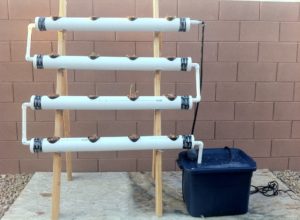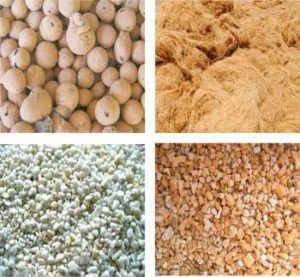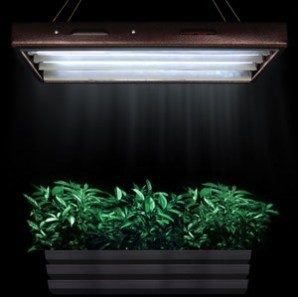Here are some simple strategies to Building an Easy Hydroponics System
Hydroponics, simply put, is a method of growing terrestrial plants in water without soil. Terrestrial plants are plants that grow on or in land/soil. Soil traps water so the roots of a plant can absorb the nutrients from the water, such as dissolved oxygen and any plant nutrients placed in the water. Soil also acts as a stabilizer for the plants. You cannot simply throw a seed in a pail of water and expect it to grow; it does need a medium, but that medium does not have to be soil. Plants can be grown anywhere there is light, either artificial or real sunlight.
The Basics
The above-depicted illustration shows the basic concept. You can use a plastic storage container, fish tank, bucket or any container that can hold water. If you are using a plastic storage container the lid can act as a grow tray by cutting holes in the lid that allow plants in a cup, for example, to be suspended above the water where the roots can dangle in the water.
http://hydroponicsgrow.org/hydroponics-cheap/
The plant tube can also be large diameter PVC piping. It has to be large enough so you can cut holes in the tubing to place the plant holders.
Get a free subscription to PREPARE Magazine
http://www.urbanfarmgarden.com/2010_11_01_archive.html
The nutrient pump is simply a small water pump similar to those used in backyard water features; it is a very small pump. An air stone can be used to aerate the water to ensure there is plenty of dissolved oxygen in the water. You can find air stones in any pet store that sells aquariums or you can use just a small water pump to keep the water agitated.
Water bubbles form when water is aerated and those bubbles rise to the surface and collect dissolved oxygen from the air and then deposit that oxygen in the water. Plants absorb water, nutrients and oxygen through their root system.
The pump pushes the water up to the grow tray and then allows it to drain back into the container. If you just use a lid with the plants suspended then the pump would be placed in a separate bucket/container to push water into the container and then have an overflow that allows water to drain back into the bucket to circulate once again through the container.
http://our.windowfarms.org/tag/hydroponic/
As you can see, you are only limited by your imagination when it comes to hydroponics. All you have to ensure is that there is a system for supporting the plants, as well as a steady flow of water across the roots.
Get a free subscription to PREPARE Magazine
To get started you can purchase seedling cups at any home and garden store or use plastic cups you have around the home. The cups must have ample holes in and around the bottom and at least half way up the sides to allow the roots to grow through to reach the water.

http://www.hydroponic-growing-systems.com/homemade-aeroponics-system.html
The depicted plant holder is one designed for aquatic plants but is ideal for a hydroponics system. It is not recommended that you use Styrofoam for seedlings or seeds; you can use foam after the plant has developed a substantial root system, to hold the plant in place. Place a hole in the middle of the foam section and then make a slit from the hole to the edge so you can open the foam piece up and slide a plant into the foam‘s center. The foam will support the plant as it grows.
http://hydroball.co.za/what_is_hydroball.php
Fill the plant holder with expandable clay, perlite, and vermiculite or coconut fiber. Perlite and vermiculite are typically mixed together and used as a growing medium.
http://www.hydroworld.co.za/hydroponic-mediums.htm
Fill the plant holder with the growing medium and place a seed or seedling in the medium and water immediately. Until the plant’s roots can reach the water, the medium must be kept damp. The above growing mediums retain moisture well, and are available in any home and garden store.
Some people have had luck using fine pea gravel or small river gravel as a growing medium. Sand and other fine materials would slip through the holes in the plant containers. This is not to say that sand cannot be a growing medium but you would have to ensure the sand is somehow contained in the plant container. Cantaloupe (muskmelon in some parts of the world) and watermelon in some areas of the country and world are routinely grown in fine gravel.
Get a free subscription to PREPARE Magazine
Lighting and Location
It is recommended that you build your hydroponics system outside if possible. This allows tomato plants to be properly hardened off and allows all of your plants to absorb natural sunlight. However, you may very well want to make your own easy hydroponics system because you cannot grow outside or simply want to grow year around. You can, of course, build your system anywhere such as a basement, garage, sunroom or even a spare bedroom.
If growing indoors, you will need ample light either by fluorescent, or by using grow lights. Fluorescent lights are typically used to supplement natural light, so if using these lights, the room in which your plants are located should receive some natural lighting through windows or skylights.
If you do not have any means of providing natural light then it is recommended that you use lights that specifically state they are plant-growing lights. These lights provide double the lighting of typical bulbs and mimic natural lighting. No special fixtures are needed(;) the bulbs can be placed and used in most fixtures you would have in your home. There are fluorescent bulbs designed as grow lights than can be used with your current fluorescent fixtures as well.
http://www.hydroponicsequipment.co/tag/indoor-gardening/
As the plants develop, you should have a system in place that allows you to raise the lighting. Always center the fixture over the plants and if you have a large number of plants, you may very well need more than one fixture. There is little overflow of lighting and most light from the bulbs is directed directly down so any plants that are in the so-called spill over lighting zone will not benefit much from the light.
Pollination
Tomatoes and any species of beans are considered self-pollinators; in other words they do not need bees, insects or humans to pollinate so they can develop a “fruit”. Cucumbers, squashes and most other vine plants do need insects, bees or humans to pollinate. Growing indoors sometimes means you will have to pollinate the plants yourself as they develop blossoms.
Collect pollen from the male cucumber blossom and pollinate the female blossom using a small soft bristled paintbrush. This method will work on any plant that produces both the male and female blossom. Simply identify each blossom and apply the described technique. You can also remove the male blossom if there appears to be an abundance of them and fold back the petals to reveal the anthers and then rub the male flower against the female flower. Male blossoms bloom and quickly fall off so it is important that you monitor closely so you can gather up the male blossoms or gather the pollen using a brush. Once pollinated the fruit behind the female blossom will begin to develop otherwise it will simply wilt away.
To see a list of plants that require bees, insects or help from humans to pollinate please visit https://en.wikipedia.org/wiki/List_of_crop_plants_pollinated_by_bees










